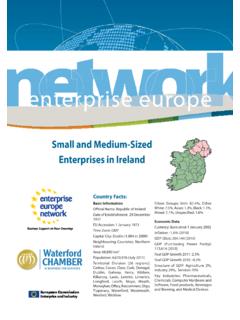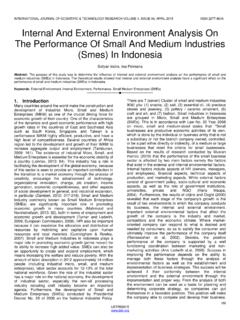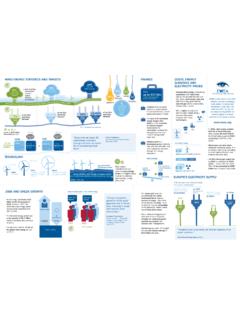Transcription of Cutting Red Tape - OECD
1 ISBN 92-64-02978-8 Cutting Red TapeNational Strategies for Administrative Simplification OECD 20069 SummaryAdministrative burden reduction policies are a priority on the political removal of measures of direct state control constitutes the main source ofregulatory improvement between 1998 and 2003. Now the emphasis falls onmeasures to remove barriers to trade, investment and entrepreneurship. Thisputs administrative simplification in the broader context of policies toenhance performance and productivity. There is a risk that administrativeregulations that are outdated or poorly designed could impede innovation andestablish barriers to entry, creating unnecessary barriers to trade, investmentand economic efficiency. Administrative burdens refer to regulatory costs in theform of asking for permits, filling out forms, and reporting and notificationrequirements for the government.
2 Red tape is particularly burdensome to smallerbusinesses and may act as a disincentive to new business start-ups. Theseeffects are more costly in global markets, where business competitiveness canbe affected by the efficiency of the domestic regulatory and administrativeenvironment. A complete halt to regulation is not a viable option. The solutionlies in the adoption of rigorous regulatory quality programmes, to createregulations that meet quality simplification is one tool to improve the quality of regulation,alongside impact assessments (RIA), consultation etc.* Efforts to reduceadministrative burdens in OECD countries have primarily been driven byambitions to improve the cost-efficiency of administrative regulations. Directadministrative compliance costs include time and money spent on formalitiesand paperwork necessary to comply with regulations.
3 Indirect or dynamiccosts arise when regulations reduce the productivity and innovativeness ofenterprises. Most of the measures and practices applied to reach this end alsoenhance transparency and 2003 OECD report on administrative simplification, From Red tape to SmartTape Administrative Simplification in OECD Countries, was based on case studiesfrom a limited range of countries at a time when the topic was new, and had astrong focus on the tools used to simplify administrative regulations.* See OECD (2002), Regulatory Policies in OECD Countries From Interventionism toRegulatory Governance for a description of the broader issues of regulatory qualityand regulatory management and RED tape : NATIONAL STRATEGIES FOR ADMINISTRATIVE SIMPLIFICATION ISBN 92-64-02978-8 OECD 200610 Expectations are greater today, and ad hoc, bottom-up simplification initiativeshave in many cases been replaced by comprehensive governmentprogrammes to reduce red tape .
4 Some instruments, such as one-stop shops,which were new then, have become widely adopted. New programmes andinitiatives are now being implemented in OECD countries, notably with afocus on quantitative strategiesExperiences have differed among OECD member countries and this is to beexpected given different government systems, differing priorities anddifferent levels of development with regard to regulatory policy and burdenreduction. However, it is possible to identify a number of overall trends in thedevelopment of administrative simplification and burden reduction policiesacross the range of countries included in this key finding of this study is that administrative simplification is becomingincreasingly embedded within the overall regulatory quality systems ofrespective countries.
5 In the past, administrative simplification was oftenundertaken on an ad hoc or sectoral basis. In most of the countries included inthis study there is now more of a whole-of-government approach to reducingburdens. Simplification is being increasingly embedded in the policy-makingprocess. Simplification strategies focus on two dimensions: ex ante control ofthe burden introduced by new regulations (a flow concept) and the reformex post of existing burdensome regulation (a stock concept). Although themajority of countries still put greater emphasis on the review of regulations expost, there is a trend towards the use of procedural controls prior to theintroduction of new legislation or regulation with a view to minimising newadministrative burdens. These controls are mainly applied during theRegulatory Impact Assessment (RIA) the focus of RIAs is not specifically on reducing administrative burdens,they do assist in stemming the tide of new burdensome regulation.
6 RIAsensure that regulatory proposals or existing regulatory arrangements aresubject to a transparent, publicly accountable and rigorous analysis todetermine if they are proportional means of meeting regulatory therefore perform a control function by promoting rational policy choiceby governments in a relatively transparent environment. Furthermore, RIAsare often subject to a centralised review or clearance by specific of the limits of attempts to improve control on rule-making ex ante is thatprior estimates of the potential burden of regulation sometimes differ fromthe actual burdens experienced in practice. To address this issue an automaticreview process can be introduced under which regulations are reviewed afterSUMMARYCUTTING RED tape : NATIONAL STRATEGIES FOR ADMINISTRATIVE SIMPLIFICATION ISBN 92-64-02978-8 OECD 200611they are implemented to ensure that they are having the intended effect.
7 Thisallows the performance of regulation to be checked against initialassumptions. Some countries have also introduced special proceduralmeasures to assess the impact of regulation on SMEs in particular, includingthe assessment of alternatives that might accomplish the stated objectiveswhile minimising the impact on small businesses. Other approaches requirespecific consultative procedures to be undertaken to ensure adequaterepresentation of the views of small has also become an important part of the burden reductionprogrammes of many countries. The focus of the measurement exercise (andsubsequent burden reduction programmes) tends to be on business, oftenwith special consideration for small and medium sized businesses, but therehas also been a trend towards measuring and reducing the burdens imposedon others, including private citizens and the not-for-profit sector.
8 Thesophistication of the measurement techniques varies between countries, butthe trend is clearly towards more sophisticated and accurate techniques thatallow a very detailed examination of the source of administrative 2005, 19 of the 22 countries reporting had a government programme toreduce administrative burdens; 14 had established a system for measuringburdens and 9 had quantitative reduction many cases, measuring systems are based on the Standard Cost Model(SCM) developed in the Netherlands, which has been introduced or adapted bya number of other countries. In 2003, some European countries formed aninformal network the SCM Network committed to using the samemethodological approach when measuring administrative burdens.
9 Thenetwork consists of Austria, Finland, Germany, Ireland, Latvia, Luxembourg,the United Kingdom, Norway, Sweden, Denmark, Belgium, Flanders (Belgium),the Netherlands, France, Hungary, Italy, the Czech Republic, Poland andEstonia. The SCM consists in breaking down legislation into informationobligations to measure the burden a single obligation imposes on strength of the model is not only its high level of detail in themeasurement of administrative costs, but also the fact that the numbersobtained are consistent across policy areas. Moreover, the model allowsgovernments to set numerical targets for burden reduction and to measureprogress towards these targets over toolsSimplification tools aim at improving the management of governments information requirements to free time and resources of those affected by theregulation.
10 In effect, they provide mechanisms by which government s broadSUMMARYCUTTING RED tape : NATIONAL STRATEGIES FOR ADMINISTRATIVE SIMPLIFICATION ISBN 92-64-02978-8 OECD 200612simplification strategies are implemented. These instruments also have theeffect of improving transparency and accountability of traditional tools for administrative simplification such as the use ofone-stop shops and process re-engineering continue to be used among OECD member countries to reduce administrative burdens. The innovation overrecent years is the increasing use of technology to facilitate this tools are increasingly being used via electronic or web-based deliveryplatforms rather than through the creation of physical raises issues of co-ordination among ministries and governmentagencies and the possibility that e-government services may be increasinglylinked in future to provide a whole-of-government access point.



















